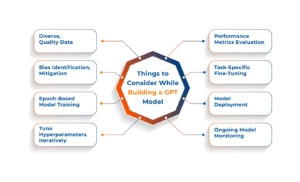Introduction: What is GPT?
GPT (Generative Pre-trained Transformer) is an advanced artificial intelligence model designed for natural language understanding and generation. Developed by OpenAI, it powers chatbots, virtual assistants, content generators, and much more. GPT models use deep learning techniques to analyze and predict text based on input, making them valuable tools across various industries.
Types of GPT Models
Different versions of GPT are available, each with varying capabilities:
- GPT-3.5: A powerful and cost-effective AI model for text generation, chatbots, and automation.
- GPT-4: The latest and most advanced model with improved reasoning, creativity, and accuracy.
- Fine-Tuned GPTs: Custom-trained models designed for specific industries such as healthcare, finance, or customer service.
- Multimodal GPTs: Models that can process both text and images, enhancing their usability in AI applications.
What Kind of Data Does GPT Require?

GPT models are trained on diverse datasets to improve their language understanding and generation capabilities. The key data sources include:
- Text-based Data: Books, articles, blogs, research papers, and Wikipedia content.
- Conversational Data: Chat logs, customer support transcripts, and social media interactions.
- Domain-Specific Data: Medical records, financial reports, legal documents, or coding repositories for specialized applications.
- Multimodal Data: Images and text pairs for models capable of understanding visuals.
Who Can Create or Use GPT?
GPT can be created or used by different groups:
- Developers: Building AI-powered applications and chatbots.
- Businesses: Automating customer service and marketing tasks.
- Content Creators: Generating articles, video scripts, and social media posts.
- Educators & Researchers: Enhancing learning materials and conducting AI research.
- Healthcare & Finance Experts: Summarizing patient records or financial reports.
Can a Non-Technical Person Create a GPT?
Yes! OpenAI and other platforms have made it easier for non-technical users to create and deploy GPT-powered models without coding expertise. Some options include:
- No-Code AI Platforms: Tools like OpenAI’s GPT Builder allow users to create AI chatbots with simple prompts.
- Pre-Trained Models: Users can customize existing GPT models with specific instructions instead of training from scratch.
- Fine-Tuning with User-Friendly Tools: Some platforms offer guided fine-tuning without requiring programming knowledge.
When to Use GPT
GPT can be utilized in multiple scenarios, including:
- Customer Support: Automating responses and improving customer service interactions.
- Content Creation: Generating blogs, product descriptions, and marketing materials.
- Programming Assistance: Helping developers with coding problems and generating scripts.
- Education and Tutoring: Providing personalized learning experiences.
- Data Analysis: Summarizing reports and identifying trends.
How to Use GPT
Using GPT effectively involves several key steps:
- Choose the Right Model: OpenAI offers different versions, such as GPT-3.5 and GPT-4, depending on your needs.
- Access the API: Sign up for OpenAI’s API or use platforms that integrate GPT functionalities.
- Fine-Tune for Specific Needs: Train the model with custom datasets for better results.
- Integrate with Applications: Use GPT with chatbots, websites, or enterprise applications.
- Optimize Performance: Set parameters such as temperature, token limits, and context length for the best results.
Steps to Create Your Own GPT Model
If you want to create your own GPT, follow these steps:
- Define Objectives: Determine the purpose of your GPT model.
- Collect Data: Gather high-quality, relevant data for training.
- Choose a Framework: Use tools like TensorFlow, PyTorch, or OpenAI’s GPT models.
- Train the Model: Fine-tune it using your dataset.
- Test and Optimize: Adjust hyperparameters for accuracy and efficiency.
- Deploy: Integrate it with applications or provide API access.
Best Practices for GPT Implementation
- Ensure Ethical AI Use: Avoid bias and misinformation in generated content.
- Optimize for Efficiency: Balance cost and performance.
- Monitor Performance: Continuously test for accuracy.
- Provide Human Oversight: AI should complement human expertise, not replace it.
Conclusion
Creating and utilizing GPT models opens up endless possibilities in various domains. Whether you’re a developer, business owner, or content creator, GPT can enhance productivity and efficiency. By following best practices and ethical AI guidelines, you can make the most out of this powerful technology.



